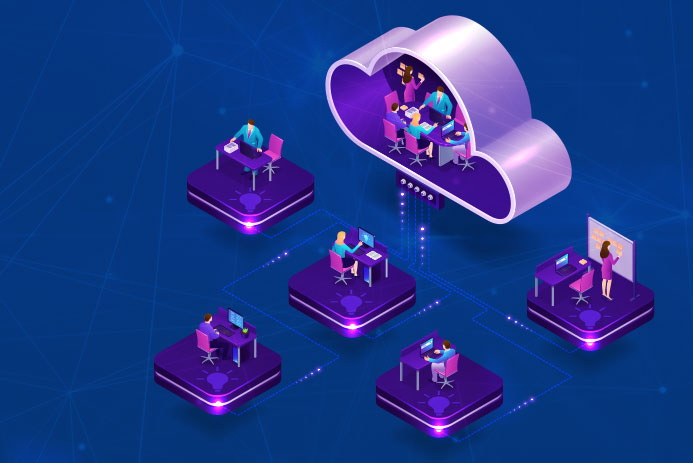Cloud
Nov 13, 2025
Leveraging Hybrid Cloud for AI & High-Performance Workloads
Artificial intelligence and high-performance computing are transforming how the world works. Every company today is becoming a computing company, driven…
Cloud
Published on October 27, 2020

At times, considered as a conflicting concept to an IT infrastructure, edge computing and cloud computing effectively complement each other’s functions. Even though they function in different ways, utilising one does not prevent the use of the other.
Cloud computing is a more common term than Edge and has been used by businesses for a long time. Businesses have favoured it due to the flexibility it provides to manage a workload on a dedicated platform in a virtual environment. However, the time it takes to communicate a task from the primary server to the client is noticeably huge when compared to edge computing. Hence, the former requires more bandwidth if connected to IoT devices.
Benefits of Cloud computing
The primary role of cloud evolves from that of an infrastructure utility to serve as a platform for the next generation of organisational innovation and evolution. Cloud computing not only allows companies to scale their operations but also provides them with the best-suited service model depending on specific requirements such as PaaS, IaaS or SaaS.
While the organisations have deployment models to choose from such as Public, Private, and Hybrid clouds, they can keep a check on the capital and operating expenses by using cloud computing. By adopting cloud strategies, enterprises have seen significant improvement in efficiency, reduction of costs, and decreased downtimes. With the recent disruption and large-scale lockdown measures due to COVID-19, the mobility, security, and scalability of cloud data platforms further highlighted its value to the businesses. The current pandemic has pushed companies to migrate to cloud environments to deal with the lockdown crisis and promote their geographically scattered teams with regular data access, sharing, and collaboration.
The relevance of Edge Computing
While cloud computing has its benefits, for improved performance and meeting more efficient computational needs, businesses are inclined towards using edge technologies. It provides a distributed communication path that works on a decentralised IT infrastructure. When transferring large quantities of data, it is essential to optimise data and complete the process in milliseconds.
Edge computing allows organisations to process, analyse, and perform necessary tasks locally on the data collected. This brings analysis closer to the data generation site eliminating intermediaries and makes it an affordable option for better asset performance. Edge computing makes it possible to utilise the full potential of the latest IoT devices which have data storage and processing power. A few areas where Edge computing has demonstrated incredible success are autonomous vehicles, streaming services, and smart homes. As new technologies like 5G networks, smart cities, and autonomous cars become common, they will integrate with, operate on, and be more dependent on edge computing resources.
Edge vs Cloud Computing
While edge computing and cloud computing are very different from each other, it is not advised to replace cloud computing with Edge. Both have different uses and purposes. Edge computing can be used for extreme latency operations and programming with varying times of run whereas cloud computing is suitable for programmes that require massive storage and provides a targeted platform. The former needs a robust and sophisticated plan for security with advanced authentication while it is easy to secure and control the latter along with remote access.
With the rise in the adoption of digital technologies, the data generated, as a result, continues to increase. And while processing these data, many organisations have started realising that there are shortfalls such as latency, cost and bandwidth in cloud computing. To help eliminate these drawbacks, enterprises are now gradually moving towards edge computing, an alternative approach to the cloud environment. Edge computing not only lowers the dependency on the cloud but simultaneously improves the speed of data processing as a result.
As IoT devices are becoming more widespread, businesses are in need to put in effect edge computing architectures to leverage the potential of this technology. Nowadays, companies are integrating edge capabilities with centralised cloud computing, and this integrated network infrastructure is called fog computing. Fog computing helps in enhancing efficiency as well as data computing competencies for cloud computing.
It is not possible to rely only on the Edge or on the cloud for your IT infrastructure but rather an amalgamation of the two that is best suited to the company’s operations. As these models become more mainstream, companies can strategise to find various hybrid structures to reduce costs and enhance their full potential.

Cloud
Nov 13, 2025
Artificial intelligence and high-performance computing are transforming how the world works. Every company today is becoming a computing company, driven…

Cloud
Nov 07, 2025
The cloud promises agility and scale. But for enterprises, it also brings the hard reality of complex management. From provisioning…

Cloud
Aug 29, 2025
Multi-cloud architecture is no longer an emerging trend; it’s an established reality. Recent industry reports show that nearly 90% of…